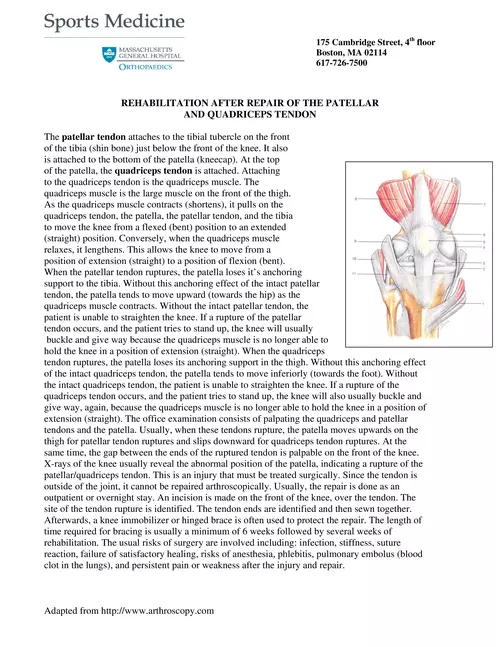
Quadriceps & Patellar Tendon Repair
Wall Squat ? Starting Position.
adsPart of the document
REHABILITATION AFTER REPAIR OF THE PATELLAR
AND QUADRICEPS TENDON
The patellar tendon attaches to the tibial tubercle on the front
of the tibia (shin bone) just below the front of the knee. It also
is attached to the bottom of the patella (kneecap). At the top
of the patella, the quadriceps tendon is attached. Attaching
to the quadriceps tendon is the quadriceps muscle. The
quadriceps muscle is the large muscle on the front of the thigh.
As the quadriceps muscle contracts (shortens), it pulls on the
quadriceps tendon, the patella, the patellar tendon, and the tibia
to move the knee from a flexed (bent) position to an extended
(straight) position. Conversely, when the quadriceps muscle
relaxes, it lengthens. This allows the knee to move from a
position of extension (straight) to a position of flexion (bent).
When the patellar tendon ruptures, the patella loses it's anchoring
support to the tibia. Without this anchoring effect of the intact patellar
tendon, the patella tends to move upward (towards the hip) as the
quadriceps muscle contracts. Without the intact patellar tendon, the
patient is unable to straighten the knee. If a rupture of the patellar
tendon occurs, and the patient tries to stand up, the knee will usually
buckle and give way because the quadriceps muscle is no longer able to
hold the knee in a position of extension (straight). When the quadriceps
tendon ruptures, the patella loses its anchoring support in the thigh. Without this anchoring effect
of the intact quadriceps tendon, the patella tends to move inferiorly (towards the foot). Without
the intact quadriceps tendon, the patient is unable to straighten the knee. If a rupture of the
quadriceps tendon occurs, and the patient tries to stand up, the knee will also usually buckle and
give way, again, because the quadriceps muscle is no longer able to hold the knee in a position of
extension (straight). The office examination consists of palpating the quadriceps and patellar
tendons and the patella. Usually, when these tendons rupture, the patella moves upwards on the
thigh for patellar tendon ruptures and slips downward for quadriceps tendon ruptures. At the
same time, the gap between the ends of the ruptured tendon is palpable on the front of the knee.
X-rays of the knee usually reveal the abnormal position of the patella, indicating a rupture of the
patellar/quadriceps tendon. This is an injury that must be treated surgically. Since the tendon is
outside of the joint, it cannot be repaired arthroscopically. Usually, the repair is done as an
outpatient or overnight stay. An incision is made on the front of the knee, over the tendon. The
site of the tendon rupture is identified. The tendon ends are identified and then sewn together.
Afterwards, a knee immobilizer or hinged brace is often used to protect the repair. The length of
time required for bracing is usually a minimum of 6 weeks followed by several weeks of
rehabilitation. The usual risks of surgery are involved including: infection, stiffness, suture
reaction, failure of satisfactory healing, risks of anesthesia, phlebitis, pulmonary embolus (blood
clot in the lungs), and persistent pain or weakness after the injury and repair.


